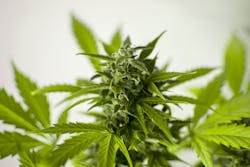Fluence research shows LED spectra and intensity can boost cannabis yield (UPDATED)
Fluence Bioengineering, an Osram subsidiary also called Fluence by Osram, has published details from two research projects that studied LED spectra and intensity impact on cannabis floral biomass yield. Generally, broad-spectrum solid-state lighting (SSL) produces superior results according to the research. Moreover, cannabis thrives under greater intensities more so than most cultivars under artificial horticultural lighting.
The latest research was conducted jointly by Fluence working with both Wageningen University and Research (WUR) in the Netherlands and with medicinal cannabis grower Texas Original Compassionate Cultivation (TOCC) based in Austin. WUR has an acclaimed horticultural program and our most recent coverage of that program focused on the autonomous tomato growing challenge that WUR hosted. Meanwhile, Fluence had announced a partnership with TOCC back in the early part of 2020. The WUR work focused on using LEDs for supplemental lighting in a greenhouse environment while the TOCC work was focused on indoor facilities where the SSL was the sole source of horticultural lighting.
Fluence has a wide portfolio or horticultural lighting fixtures in various form factors. And across the luminaire portfolio, the company offers spectra or spectral power distribution (SPD) options as well. Each SPD option is branded PhysioSpec. There are PhysioSpec Dual options that use monochromatic red and blue LEDs to deliver two radiation bands that together produce the pink light often seen in grow facilities. The company also offers a PhysioSpec Mono option with a single monochromatic channel intended for use at a specific cultivar growth stage to coerce a desired photomorphogenic response.
The WUR and TOCC research, however, showed that the PhysioSpec Broad options that deliver energy over the 400–700-nm PAR (photosynthetically active radiation) range generate better yield with the cannabis cultivar. Fluence offers multiple versions of the Broad SPD that have different mixes of LEDs utilized in the fixture.
“Cannabis bud quality, yield, and consistency were remarkably strong when grown under Fluence’s PhysioSpec Spectrum Broad R4 white light,” said David Hawley, Fluence’s senior scientist. In the indoor trial at TOCC, the researchers determined that the Broad R4 SPD yielded 20% more flower biomass on average than the Broad R6 and 9% more than the Broad R8. With some strains of the cultivar, the advantages of the Broad R4 stretch to 31%.
In both the WUR and the TOCC projects, Fluence hoped to learn more about pushing the intensity of the horticultural lighting to levels beyond what most cultivars could take. Indeed, our keynote speaker at HortiCann Light + Tech in October 2020, Bruce Bugbee of Utah State University, made the point of cannabis and its affinity for intensity.
The WUR greenhouse experiments did not reveal an advantage tied to lower intensities. The broad spectrum was still critical for optimum cannabinoid and terpene concentrations at low intensity. High intensity in the greenhouse adds the yield boost. In the indoor research, higher intensity is considered to be a key enabler of yield improvements.
“Unlike other commercial crops, greenhouse cultivators can grow cannabis with far greater intensities of supplemental light due to the plant’s photosynthetic capacity,” said Hawley. “To optimize yield, growers should consider light intensities that are dramatically higher than industry norms while paying close attention to spectral quality. Our high-intensity indoor trials affirmed that cannabis growers — whether indoor or in greenhouses — who apply Broad R4 will maximize yield and secondary metabolite production.”
The one issue with the Fluence research is that the company does not openly revel the SPD details of its various spectra offerings. Moreover, other details are lacking in the recent announcement such as precise methodology. We will update this story if we receive more details.
Meanwhile, we will call your attention to another recent Fluence announcement that we posted in the Company Newsfeed section of our website. The company released details of its fifth annual “State of the Cannabis Lighting Market” report. Fluence asserts that LED usage across all stages of cannabis cultivation has tripled over the past five years. Furthermore, spectra is now considered as important as intensity in grower buying decisions today.
*Updated Jan. 6, 2021 9:00 AM for correction of Broad R4 SPD.
For up-to-the-minute LED and SSL updates, why not follow us on Twitter? You’ll find curated content and commentary, as well as information on industry events, webcasts, and surveys on our LinkedIn Company Page and our Facebook page.

Maury Wright | Editor in Chief
Maury Wright is an electronics engineer turned technology journalist, who has focused specifically on the LED & Lighting industry for the past decade. Wright first wrote for LEDs Magazine as a contractor in 2010, and took over as Editor-in-Chief in 2012. He has broad experience in technology areas ranging from microprocessors to digital media to wireless networks that he gained over 30 years in the trade press. Wright has experience running global editorial operations, such as during his tenure as worldwide editorial director of EDN Magazine, and has been instrumental in launching publication websites going back to the earliest days of the Internet. Wright has won numerous industry awards, including multiple ASBPE national awards for B2B journalism excellence, and has received finalist recognition for LEDs Magazine in the FOLIO Eddie Awards. He received a BS in electrical engineering from Auburn University.





